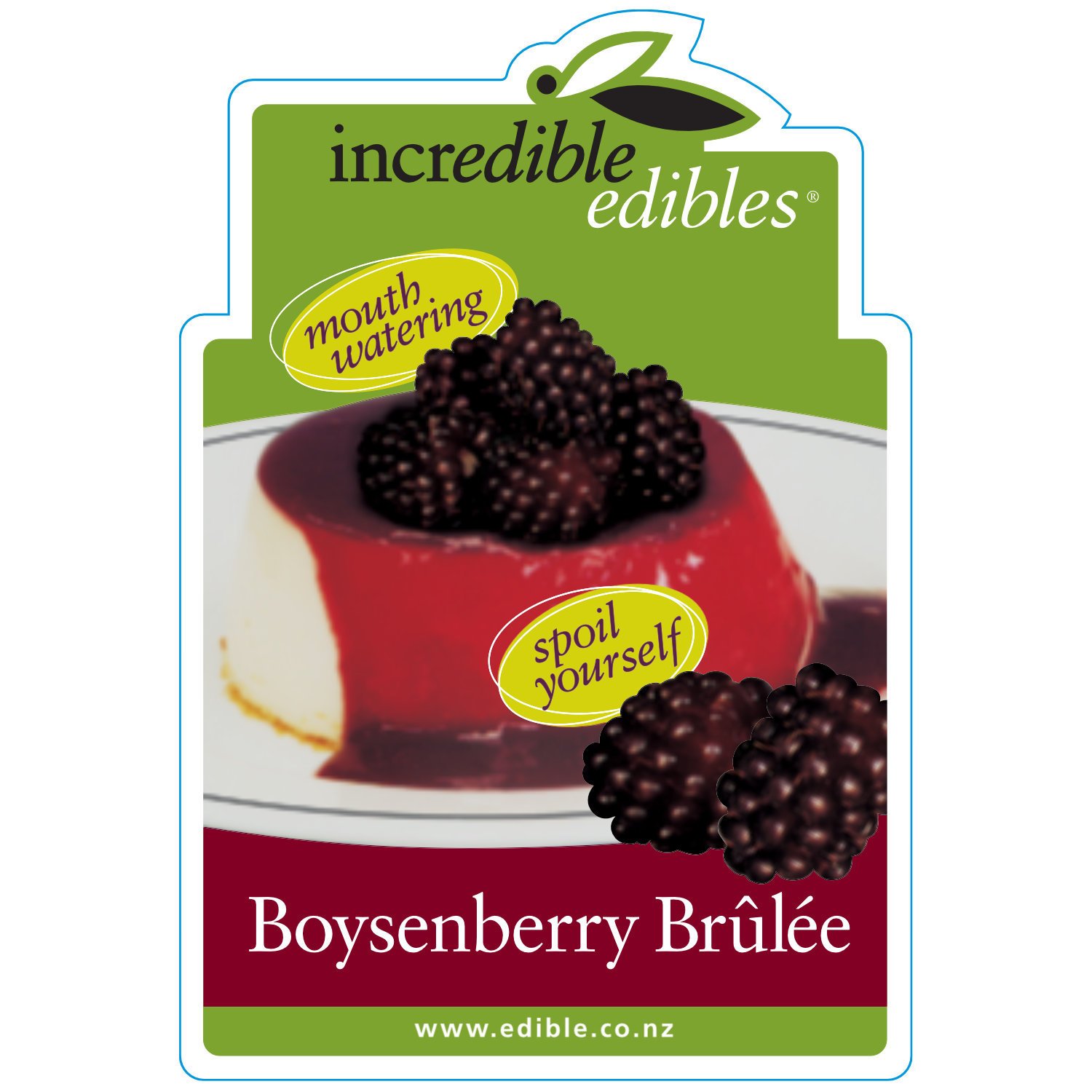 Image 1 of 4
Image 1 of 4

 Image 2 of 4
Image 2 of 4

 Image 3 of 4
Image 3 of 4

 Image 4 of 4
Image 4 of 4





Boysenberry Brulee
White flowers appear in spring and will be followed by large firm conical dark purple fruit. Boysenberry Brulee is moderately vigorous, mostly spineless canes. It is self-fertile and pollinated by insects and bees. Brulee is a cross between a Blackberry and a Raspberry and grows New Zealand wide.
Boysenberry Brulee should be ready for harvesting over February and March (late season). The best way to have Boysenberries is to eat them fresh from the plant. Excess boysenberries can be chilled for later use in desserts, fresh summer salad, or added to a bowl of ice-cream. The berries are ready when easily removed. Boysenberries are high in antioxidants and rich in Vitamin C.
Check out our Berry Coulis recipe inspiration page, to lift your ice cream, cheesecake or yoghurt to the next level.
Plant in full sun and protect from wind (including salty sea winds). Plant in a well-drained position with good moisture content and high in organic matter, as this will see the plant thrive. (Mulch annually in spring). Like any deciduous fruiting plant, they benefit from Copper and Oil sprays during winter to help keep the plant healthy and disease-free.
Pruning all brambles involves tying up strong canes produced in spring and summer and removing thin, weak, and wandering canes. In late summer - early autumn, remove 10cm of the terminal growth of the canes. This will initiate the production of fruiting spurs. Remove fruited canes from the soil base in autumn (or winter in cooler, dryer areas).
Rubus Hybrid ‘Brulee’
White flowers appear in spring and will be followed by large firm conical dark purple fruit. Boysenberry Brulee is moderately vigorous, mostly spineless canes. It is self-fertile and pollinated by insects and bees. Brulee is a cross between a Blackberry and a Raspberry and grows New Zealand wide.
Boysenberry Brulee should be ready for harvesting over February and March (late season). The best way to have Boysenberries is to eat them fresh from the plant. Excess boysenberries can be chilled for later use in desserts, fresh summer salad, or added to a bowl of ice-cream. The berries are ready when easily removed. Boysenberries are high in antioxidants and rich in Vitamin C.
Check out our Berry Coulis recipe inspiration page, to lift your ice cream, cheesecake or yoghurt to the next level.
Plant in full sun and protect from wind (including salty sea winds). Plant in a well-drained position with good moisture content and high in organic matter, as this will see the plant thrive. (Mulch annually in spring). Like any deciduous fruiting plant, they benefit from Copper and Oil sprays during winter to help keep the plant healthy and disease-free.
Pruning all brambles involves tying up strong canes produced in spring and summer and removing thin, weak, and wandering canes. In late summer - early autumn, remove 10cm of the terminal growth of the canes. This will initiate the production of fruiting spurs. Remove fruited canes from the soil base in autumn (or winter in cooler, dryer areas).
Rubus Hybrid ‘Brulee’
White flowers appear in spring and will be followed by large firm conical dark purple fruit. Boysenberry Brulee is moderately vigorous, mostly spineless canes. It is self-fertile and pollinated by insects and bees. Brulee is a cross between a Blackberry and a Raspberry and grows New Zealand wide.
Boysenberry Brulee should be ready for harvesting over February and March (late season). The best way to have Boysenberries is to eat them fresh from the plant. Excess boysenberries can be chilled for later use in desserts, fresh summer salad, or added to a bowl of ice-cream. The berries are ready when easily removed. Boysenberries are high in antioxidants and rich in Vitamin C.
Check out our Berry Coulis recipe inspiration page, to lift your ice cream, cheesecake or yoghurt to the next level.
Plant in full sun and protect from wind (including salty sea winds). Plant in a well-drained position with good moisture content and high in organic matter, as this will see the plant thrive. (Mulch annually in spring). Like any deciduous fruiting plant, they benefit from Copper and Oil sprays during winter to help keep the plant healthy and disease-free.
Pruning all brambles involves tying up strong canes produced in spring and summer and removing thin, weak, and wandering canes. In late summer - early autumn, remove 10cm of the terminal growth of the canes. This will initiate the production of fruiting spurs. Remove fruited canes from the soil base in autumn (or winter in cooler, dryer areas).
Rubus Hybrid ‘Brulee’

